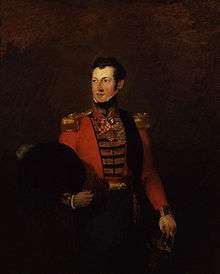Robert Henry Dick

Sir Robert Henry Dick KCB KCH, KOV (29 July 1787 – 10 February 1846) was a Scottish soldier, son of a doctor in the East India Company's service.
Military career
He entered the British Army in 1800 serving in the 75th Regiment. He was lieutenant in the 42nd Regiment of Foot in 1804.[1] He served as an officer in the 42nd Regiment of Foot serving in the Peninsular War. He fought at Buçaco, Fuentes de Oñoro, and Salamanca. He distinguished himself at Quatre Bras and Waterloo
1814 he received his C.B. 1832 he received his K.C.H. 1838 he received his K.C.B.
In 1837, he was promoted to be major general, and in 1841–1842 was acting Commander-in-Chief at Madras. In 1846, he assumed command of the Third Infantry Division in the Sikh War. He fell while leading a second charge against Sikh entrenchments at Sobraon.[2]
Memorials
He is buried at Ferozepore:
Here lies in the hope of joyful resurrection Sir Robert Henry Dick of Tully Mett, Perthshire N.B. Major-General Knight Commander of the Orders of the Bath and of Hanover, Knight of the Austrian Military Order of Maria Theresa and of the Russian Order of Vladimir. Colonel of H.M. 73rd Regt. For his country he fought & bled: in Egypt at Maida thro'out the Peninsula at Waterloo & in India. For his valour and skill at Fuentes d'onor Busaco Salamanca and Waterloo he received two medals and two honorary clasps. Born on 29 July 1787 AD he fell in the moment of victory on the 10th Feby 1846 AD while cheering on H.M's 80th Regt having led his division in the assault on the entrenched camp of the Seikh at Sobraon. Honoured and beloved he lived honoured and lamented he died.[3]
Memorial at Dunkeld Cathedral, Dunkeld, Tayside:
Sacred to the memory of Major-General Sir Robert Henry Dick KCB KCH who after distinguished service in the Peninsula in the command of a Light Battalion and at Waterloo with the 42nd Royal Highland Regiment fell mortally wounded whilst leading the 3rd Division of the Army of the Sutledge to the attack on the Seikh entrenched camp at Sobraon on 10 February 1846. The officers who had the honour of serving under him in his last battle and other friends in Her Majesty's and the Honourable East India Company's Service in Bengal have caused this monument to be placed in his parish church.[4]
A memorial also exists in St Giles Cathedral in Edinburgh.[5]
His portrait, by William Salter, is in the National Portrait Gallery.[6]
References
- ↑ http://www.electricscotland.com/history/scotreg/bwatch/bw21.htm
- ↑ The Gentleman's magazine, Volume 188, F. Jefferies, 1850
- ↑ http://glosters.tripod.com/Aliwal.htm
- ↑ Journal of a cavalry officer: including the memorable Sikh campaign of 1845-46, William Wellington Waterloo Humbly, Longman, Brown, Green, and Longmans, 1854
- ↑ Monuments and Monumental Inscriptions in Scotland: The Grampian Society 1871
- ↑ http://www.oceansbridge.com/oil-paintings/product/88842
 This article incorporates text from a publication now in the public domain: Gilman, D. C.; Thurston, H. T.; Colby, F. M., eds. (1905). "article name needed". New International Encyclopedia (1st ed.). New York: Dodd, Mead.
This article incorporates text from a publication now in the public domain: Gilman, D. C.; Thurston, H. T.; Colby, F. M., eds. (1905). "article name needed". New International Encyclopedia (1st ed.). New York: Dodd, Mead.